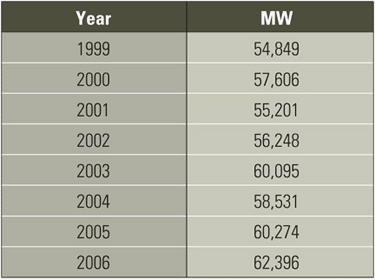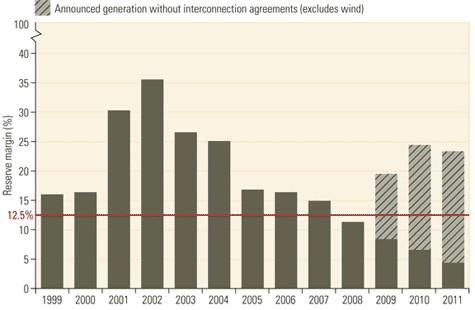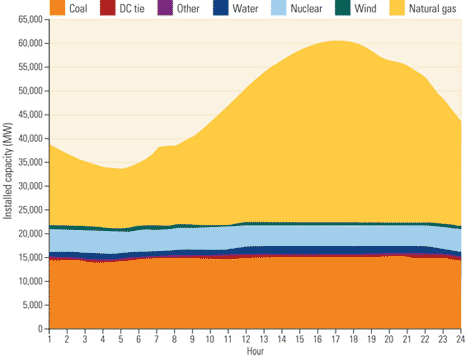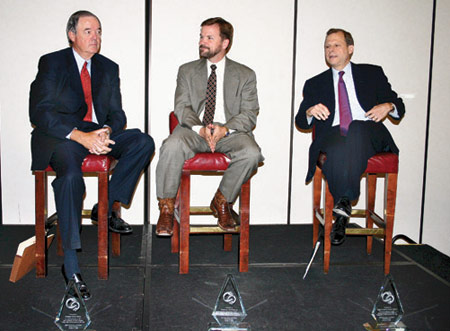Global Monitor
Dec 2006
Gulf Coast Power Association conference report |
 |
Members of the Gulf Coast Power Association (GCPA) gathered in Austin, Texas, on October 4 and 5 for their annual meeting and a celebration of the group's 20th anniversary. Hatched as the Gulf Coast Cogeneration Association in 1984 with 12 engineers, GCCA admitted Cogen Technologies as its first corporate member. During the 1980s, the upstart cogenerators competed with the much larger investor-owned utilities. In the '90s, non-utility generators, independent power producers, and exempt wholesale generators were born with the creation of the wholesale market by the Energy Policy Act of 1992.
At the meeting, more than 350 attendees shared their assessments of the successes and failures of deregulation in the Electric Reliability Council of Texas (ERCOT) market. Most considered the Texas model a shining success that established the "truest" electricity market in North America. Addressing the theme of the meeting—"Building on Success: Adapting to the New Challenges in the Texas Electric Market"—almost all presenters called for three things: additional generation capacity, renewable energy, and demand response.
The guest speakers were considered the rock stars of deregulated power in Texas. Before a packed house over lunch, they shared what they"d learned in the recent past and gave their predictions for the future.
ERCOT gains momentum. The GCPA's keynote address was delivered by Paul Hudson, chairman of the Public Utility Commission of Texas (PUCT) since 2003. Hudson said Texas really has three categories of customers:
- Non-ERCOT. These are end users in those portions of the state outside ERCOT's electrical wiring diagram—in other words, customers of SWEPCO, SPS, Lubbock Power & Light, Entergy, and El Paso Electric whose rates are still regulated by the PUCT.
- ERCOT, retail open. These users are in portions of the state where retail competition was established in early 2002. Distribution grids there are owned by AEP, Centerpoint, and TXU. ERCOT has more than 100 registered retail providers.
- ERCOT, retail closed. These customers live in areas served by municipal and co-op utilities that choose not to offer retail choice. Two of the largest munis are operated by the cities of Austin and San Antonio.
Hudson discussed the issues that keep him awake at night and, in particular, his concern that new generating capacity won't get built in time. ERCOT experienced record peak demand of 62,396 MW on August 18, 2006 (Figure 6 and table). Forecast demand for 2025 (plus a 12% reserve margin) is 100,000 MW. But the long-term supply/demand gap is actually greater than 30+ GW because much existing capacity is already 20 to 30 years old and thus will be need to be retired and replaced.

6. Everything's bigger in Texas. This chart shows total generation in the ERCOT region in recent years. Source: ERCOT

Peak demand history. Source: ERCOT
Turning to the shorter term, Hudson predicted that reserve margins in Texas will fall into the single digits between 2007 and 2009 due to the time it takes new projects to get permitted and constructed (Figure 7). Of the 8,500 MW of old capacity that have been mothballed, 1,100 MW have already been returned to service, and chances are that more will be called back between 2007 and 2009.

7. Lights out? These are the past and projected ERCOT reserve margins (the percentage by which total supply exceeds peak demand) from 1999 through 2011. The margin is expected to dip below the 12.5% "Safe level" by 2009. Over 26,000 MW of new generation were added after passage of Senate Bill 7. Since 1999, 2,800 MW have been retired and 8,700 MW have been mothballed (1,100 MW of which have been returned to service). Note that future generation is officially counted only if interconnection agreements are completed. Source: ERCOT
Hudson also expressed concern about the "gas hangover" from Hurricanes Katrina and Rita. In ERCOT, the current price to beat (PTB) ranges from 14.5 to 16.3 cents/kWh. The best retail prices range from 12.5 to 12.9 cents/kWh. The current 20-day forward rolling average price for gas is $7.74/mmBtu. Hudson then asked, if gas-fired generation produces more than 50% of the electrical energy in ERCOT and wholesale prices are falling, why hasn't the retail price per kWh fallen as fast? He encouraged all retailers to take the gloves off now and to get aggressive on price. Remember, Hudson added, on January 1, 2007, the PTB officially goes away. So on that day the incumbents (TXU and Reliant are the gorillas) can reduce their prices to win back lost customers and attract new ones.
All eyes also will be on Entergy this coming New Year's Day, because that's when the utility will submit its "transition to competition" plan to the PUCT. The commission says it hopes to give a thumbs-up or -down to the plan within 180 days.
Hudson also touched on how to import capacity from outside ERCOT and how to pay for it. He noted that it would probably make sense to extend ERCOT's transmission line 2 miles to pick up 1,000 MW—but not 1,000 miles to pick up 2 MW. Somewhere in the middle lies the right economic balance.
In September 2003 the PUCT ordered ERCOT to develop a nodal wholesale market design. Implementation is expected to deliver improved price signals and dispatch efficiencies as well as direct assignment of local congestion. The transition to the nodal market will require significant changes to ERCOT's current business model, including the day-ahead market, reliability unit commitment, real-time or security-constrained economic dispatch, and congestion revenue rights. ERCOT's cost to purchase and deploy computers and software could exceed $200 million by 2008.
ERCOT: A partnership in transition. Sam Jones, ERCOT's CEO, followed Hudson by reviewing the history of ERCOT since it became the Federal Energy Regulatory Commission's first independent system operator (ISO) in 1996. As Figure 6 shows, between 1995 and 2005 total electricity delivered in ERCOT increased 30% from 230 million MWh to 300 million MWh.
ERCOT may be proud of its success in creating choice for industrial, commercial, and residential customers, but plenty of challenges remain. The major near-term challenges are the aforementioned shrinking reserve margin and the dominance of natural gas (which currently fuels 72% of generation capacity) within the fuel mix (Figure 8). As Figure 7 shows, ERCOT expects its reserve margin to fall below the targeted "Safe" level sometime in the 2007–2009 time frame. Although project development activity has picked up, advanced development (as measured by the number of executed interconnect agreements) is lagging. Most of the advanced development is gas-fired, exacerbating the existing fuel-diversity problem. For this reason, ERCOT is establishing better incentives for voluntary load reduction by customers to reduce on-peak demand.

8. Cooking with gas. Typical ERCOT load profile (August 23, 2006). Source: ERCOT
Some interesting opinions were voiced by Tom Payton, VP for power at Occidental Energy Ventures. Payton challenged ERCOT to take leadership in the policy change arena and "not behave like a regulated utility" by simply taking direction from the PUCT. ERCOT needs to be a proactive leader, not just a facilitator, he said, adding that he feels ERCOT caters too much to stakeholders. "Stakeholders should not decide policy. ERCOT's board should work for consumers," Payton advised.
Another hot topic was capacity payments. Currently, there is no payment for capacity in ERCOT, only for energy. It was noted that among the nine ISOs in the U.S., only two (ERCOT and MISO) offer no installed capacity or locational installed capacity payments.
Wind power in Texas. Texas is moving aggressively to increase the share of renewable energy in its generation mix. Indeed, this year it overtook California as the state with the most installed wind power capacity. During 2005, the Texas legislature passed Senate Bill 20 (SB20), which established renewable capacity goals of 5,880 MW by 2015 and 10,000 MW by 2025. About 95% of the renewable capacity is likely to be wind power. But although it takes only one or two years to develop and build a wind farm, it takes five years or more to install the associated transmission capacity.
SB20 includes a program being called Competitive Renewable Energy Zones (CREZ) to give priority for transmission funding to the sites with the best wind power potential. The PUCT is planning to fund up to $2 billion in transmission improvements to make sure that the renewable power gets to market. Projects will compete for transmission access. Developers would have to put up deposit money to reserve transmission space.
Developers, however, are already complaining that, although they must submit a completed interconnect agreement (accompanied by a deposit) at the front end of a project, financing won't become available until a "certificate of convenience and need" (CNN) is obtained. Developers would like not to have to submit the deposit until receiving the CNN. Two other concerns of developers are that gas- and coal-fired projects will try to grab the allocated capacity and that one well-funded wind developer might try to hog a large proportion of the new transmission.
Resource adequacy in an energy-only market. At the GCPA annual meeting, there was a spirited debate among panelists suggesting the best market design to stimulate demand response (DR). Dan Gabeldon of Booz Allen Hamilton lamented the use of price caps, which usually are arbitrary, to create "missing money" from a free market that rightfully belongs to owners of peaking capacity. Steve Winn of NRG echoed these remarks and noted that, even without a cap, peakers normally quote below the true market price due to the bad image created by someone looking to exploit a supply shortage. Bill Bojorquez, director of system planning for ERCOT, felt that it was already too late to build and connect any new generation to avoid the reserve margin shortfall projected for 2007–2009. The only viable near-term choices, he said, are to unmothball capacity or come up with a DR program . . . immediately.
Trudy Harper of Tenaska presented her straw man DR proposal. In her scheme, each seller of electricity serving a real load would be responsible for arranging an additional 12.5% capacity. At the end of each month in which the reserve margin was less than 12.5% at the hour of peak demand, a penalty would be assessed the providers that did not have 12.5% reserve, and the money would be paid to the providers that did. Harper said that because an energy-only market would lead to capacity shortages, only a properly managed DR program would provide the needed capacity more cheaply than building new plants.
Nat Treadway of Distributed Energy Financial Group noted that, of the 1,800 MW of interruptible load in ERCOT today, about 1,150 MW are available at any moment. Other regions in the U.S. have done a better job of creating a competitive market for DR, he said. Another panel of technology experts pointed out that the infrastructure needed for a robust DR program would consist of intelligent meters with two-way communications capability. They added that the installed cost of a smart meter to a residential customer is in the range of $100 to $150—that is, if the program is implemented at full scale, not customer by customer.
Superstar panel discussion. Three of the people most responsible for creating and nurturing deregulation in Texas were presented awards by GCPA Executive Director John Stauffacher. They were: David Sibley, former Texas state senator; Steve Wolens, former Texas state representative; and Pat Wood, former chairman of both the PUCT and FERC (Figure 9).

9. Honoring industry leaders. The Gulf Coast Power Association honored (L to R) Pat Wood, former chairman of both the Public Utility Commission of Texas and the Federal Energy Regulatory Commission; David Sibley, former Texas state senator; and Steve Wolens, former Texas state representative, for their contributions to electricity deregulation in Texas. Courtesy: Mark Axford
In his remarks, Wolens recalled traveling to California in 1997 with Sibley and Wood to learn what not to do. They came up with the concept of the "price to beat" during another road trip to Pennsylvania and still consider PTB the bedrock of ERCOT's success. The California PUC told them, "Be sure to spend money to educate the customers." Texas spent $18 million in 2003, but funding was slashed to $1.5 million per year thereafter as state budgetary pressure took its toll. Wolens noted, "We've come a long way, but there still isn't enough difference in the prices offered by the many retail providers. We haven't seen one company emerge with a truly unique approach and become the 'Southwest Airlines of electricity.' "
Sibley recapped the primary goals of Texas Senate Bill 7: To transfer risk to the seller and empower the consumer. He said he wished that he would have saved the napkin used to scratch out the PTB structure on the trip home from Pennsylvania. "One of the best things about the model is that the market moved us to plants that are more efficient," he added.
Wood (see box) rattled off a list of things that, with 20/20 hindsight, would have produced a better outcome. He said he felt that the march to deregulation was weak on innovative technology. Like Wolens, Wood agonized about the budget cuts for education needed to teach consumers about the market and their choices. The market design failed to account for negative stranded costs and did not envision the need to index the PTB to the cost of fuel. Also, there was not enough emphasis on tying ERCOT to adjacent regions in Texas. Wood is a big fan of the nodal market's promise for relieving congestion, perhaps first at the wholesale level, then retail, and finally at the neighborhood level. Wood said he's amazed that the prediction of 40% market share loss by incumbents in the PTB program was, in fact, very accurate.
